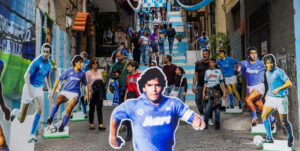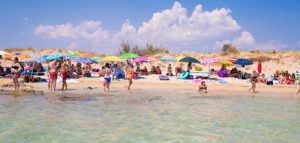Venice has a cruel habit of defeating her admirers. Even her most confident suitors, who arrive via water taxi intent on enjoying all her charms and treasures, return home heavy with second-rate vongole and the humiliation of that unseen Titian. I was left in tears on a Venetian quayside when, after a long day of sight-seeing, I thought I had missed the once-a-day boat crossing to San Francesco del Deserto, the mystical island that Saint Francis had visited on his way back from Africa.
Luckily, there’s a cure for our heartache: Venice for Pleasure. This irreverent guidebook by the English art historian J.G. Links promises “a guide to the pleasures of Venice without its pains”, which, in our era of frantic mini-breaks — of Instagramming and TikToking our way around as many must-see landmarks as possible — is a marvel and a revelation.
“Very few travellers seem to enjoy their first visit to Venice,” Links cautions. “They are awed, dazzled, overwhelmed… [but] above all, they are exhausted by it; physically, mentally and emotionally, its assault is too much for the ordinary human being to withstand.” This is a book for that wild curiosity: a tourist in pure pursuit of pleasure. If they follow Links, they may end up skipping their three-hour tour of the Doge’s Palace, but “Venice will have woven its spell around them, and they will be captives for life.”
Links asks just one thing: that everyone be a walker, “or, at least, a dawdler”. And that is because his guide consists of four narrated walks around Venice, from the shimmering Zattere to the lonely Cannaregio. The streets, Links says, have “a miraculous spring in the paving which makes fatigue almost impossible”. And he is careful to stop at “as many cafes as possible” for coffee or apéritif, from where he enchants us with stories and architectural details about nearby palaces, churches and bell towers contemplating collapse.
With Links as a guide, the idea that Venice is somehow not real — that it is a circus, a Disneyland, a fossil — is banished. On my own strolls, I have seen drowsy postmen loading Amazon parcels onto little delivery boats at dawn; babbling Venetians spilling out of a bar onto the canal, eating baccalà mantecato and drinking wine from paper cups; families fleeing the stink of the summer to the furthest beach on the Lido; a seagull losing a brawl with a lagoon squid, turning the water jet black; a distressed elderly gentleman who has misplaced a valuable miniature he was hoping to sell. This is not a city without a soul.
There is another side to Venice: the merciless tour guides; the menageries of Murano glass animals; the overpriced, often-disappointing food (there is nothing worse than that fearful “delicacy”, the Venetian soft-shell crab, plucked from its squalid existence on the lagoon floor for your displeasure). Even Jan Morris, a lifelong admirer, admitted to feeling that tourism was “in some sense a prostitution of a great city, a degradation, a shame”.
But who’s to say that this carnival of profit isn’t real in its own way? The Venetians have been playing this same game since the 16th century, when, long after their blood-soaked earnings from the Crusades dried up, Venice devoted herself to readying pilgrims for the Holy Land. The piazza was full of Venetians flogging guidebooks, insecticides, and religious tat. Five centuries on, they’re still at it — and next Spring, we’ll be charged €5 entry to the city.
Earlier this year, my devoutly romantic friend took a photograph of a gondolier teaching his son to row in the moonlight: passing down his trade to the next generation. If he were canny, he would have also advised his boy on how to squeeze the most money out of unsuspecting tourists. But would this have made the scene any less remarkable? Any less Venetian? Certainly not.
There is a strong case in Venice for leaning into the artifice, for ditching our snobby disdain for anything that feels touristy. It is the burden of the Brit in Italy to live in dread of encountering a fellow countryman: to be sat next to another British tourist in a restaurant is the ultimate catastrophe. But what do we gain from this manic pursuit of authenticity? And what counts as an “authentic” experience abroad anyway? Is it to surround yourself with Venetians chatting and drinking in Campo Santa Margherita — even if the most you can say in Italian is ciao bella? Perhaps we’re simply chasing an illusion.
Nowhere is this question more relevant than in the gold-leaf excess of Florian’s Cafe in San Marco. I went there one morning on the advice of Links (whose book is, admittedly, now a little behind on the cafe scene), and was so horrified at the thought of paying €12 for a hot chocolate, only to sit amid a throng of fellow tourists goggling and waving selfie sticks, that I upped and left. I later regretted it. Florian’s, I imagine, has been fleecing foreigners for 300 years. It is hardly inauthentic.
In fact, having lost her empire, Venice revelled in her duplicity, fashioning herself a new role as entertainer of the world. “Venice had given herself over to pleasure — but she still made it good business,” Links writes of the 18th century. “Her pageants and carnivals, her theatres and balls, were as much designed to attract the tourists as to make the Venetians themselves forget past glories.”
Yet Venice never let herself fade completely into gilded irrelevance. Even now, she is more than just a honeymoon city, a reliquary of bygone beauty. She is the home of the Biennale, the Film Festival, the Peggy Guggenheim collection, and a mother to the finest exhibitions of Venetian art. It is part of the fun to walk into a prim-looking church, only to find soft-porn playing above the altar, with humourless aesthetes watching from Play-Doh beanbags. Venice is both the art world’s greatest muse — and its harshest critic.
For Jan Morris, this was never enough. She dreamed that the city would once again become a noble marketplace. “East and West might meet once more,” she writes in Venice, “to fuse their philosophies at last, and settle their squalid bickerings… Venice is made for greatness, a God-built city, and her obvious destiny is mediation. She only awaits a summons.” It’s a beguiling vision, and one that could perhaps inspire Britain too, as it struggles to accept its waning status in the world.
As for the “perennial tourist”, we have begun a love affair with Venice that will last a lifetime — unless, like all the great romances, she sinks before we do. We can choose whether to drink hot chocolate at Florian’s or to amble along the quiet streets of Dorsoduro, knowing that each experience is just as authentic; just as Venetian. Because Venice has always been an exhibitionist. And in Venice, as in life, it is often the performance that is most real.
Disclaimer
Some of the posts we share are controversial and we do not necessarily agree with them in the whole extend. Sometimes we agree with the content or part of it but we do not agree with the narration or language. Nevertheless we find them somehow interesting, valuable and/or informative or we share them, because we strongly believe in freedom of speech, free press and journalism. We strongly encourage you to have a critical approach to all the content, do your own research and analysis to build your own opinion.
We would be glad to have your feedback.
Source: UnHerd Read the original article here: https://unherd.com/



